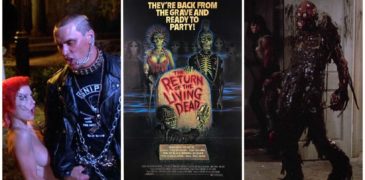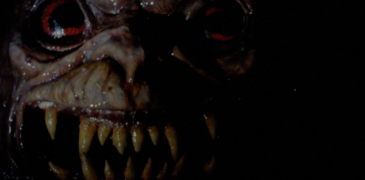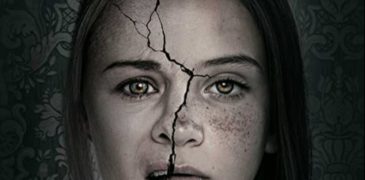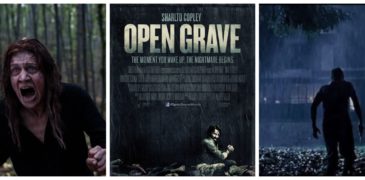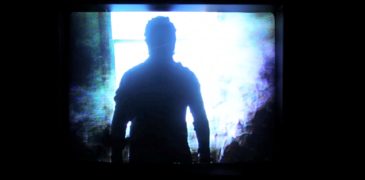
With 2024’s Terrifier 3 breaking the box office record for the highest-grossing unrated film of all time, Damien Leone’s iconic character Art the Clown has blown up as a pop culture icon. Art’s admittedly grotesque visage appears on t-shirts and posters, his likeness is replicated by countless cosplayers, and he even has a massive online following with one online group, “Art the Clown Appreciation Society” boasting nearly 50 thousand members, not to mention the many other Terrifier fan groups with followers in the thousands as well. With Art’s sudden and somewhat unexpected rise to stardom, we decided to take a look at the feature-length indie-horror flick that started it all: 2013’s All Hallow’s Eve.
Many horror fans will say that Art the Clown made his terrifying debut in the 2016 slasher film Terrifier, but true Art aficionados know he actually got his start in the feature-length low-budget horror anthology All Hallow’s Eve. Directed by Damien Leone, 2013’s All Hallow’s Eve consisted of three increasingly bizarre tales all connected by the silently spooky character Art the Clown, whose unexplained appearances seemed more and more disturbing throughout the film. Framed in a simple narrative involving the classic horror tropes of a babysitter, two kids on Halloween night, and a mysterious VHS tape, All Hallow’s Eve brings a rising sense of dread to its stories, making it a chilling watch for fans of low-budget and indie horror, and gaining it a significant cult following.
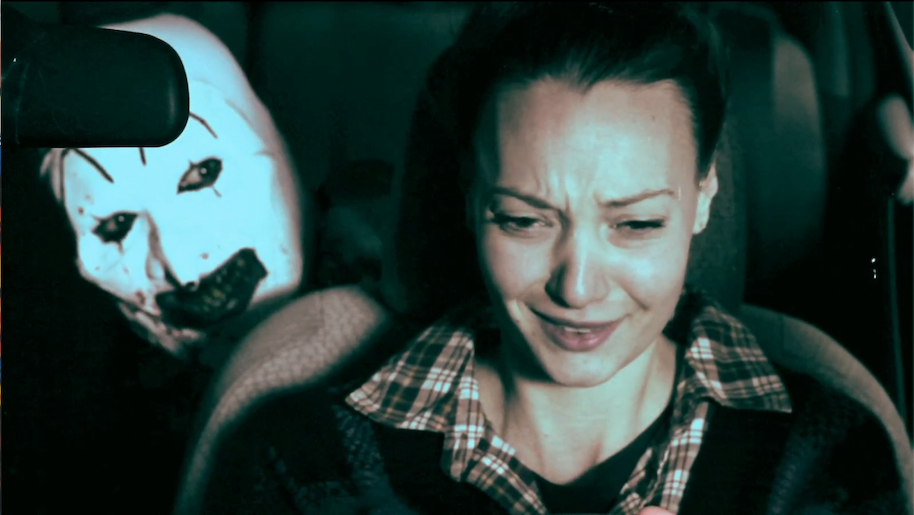
The film opens on Halloween night, where Sarah, a totally over-it babysitter, discovers an unmarked VHS tape in one of the trick-or-treat bags of the children she’s charged with looking after. After much convincing from the kids, she reluctantly plays the tape, revealing three disturbing short stories, all connected by Art the Clown. This framing device, although simple, draws viewers into the terror and helps make the anthology feel cohesive, rather than just a series of mostly unrelated stories. The premise of finding a cursed or haunted video isn’t new to horror fans, but the director, Damien Leone, uses it well, and the limited setting of an average suburban bungalow heightens the sense of dread that builds as each story unfolds and gives viewers the uneasy feeling that they can’t just walk away from the bizarre tape.
The first story involves a young woman stranded at a gas station who finds herself in a nightmarish encounter with Art. The second segment ventures into science-fiction territory with aliens and home invasions, while the third brings the horror underground with a ritualistic cult. While each story has distinct elements of horror, they vary greatly in tone and impact, which helps keep the film moving along and prevents it from feeling stagnant or one-note. Of the three films, the first one stands out as the most unsettling, perhaps because it gives us a first look at Art the Clown, or perhaps because viewers go into the first film with no idea what to expect from it. Leone’s directorial style is raw and gritty, which works well to bring a sense of realism and tension to these stories and gives it that gross, unpolished, early 2000s horror film look that fans love. All in all, the film leaves you feeling grimy and a bit violated, but in the best possible way.
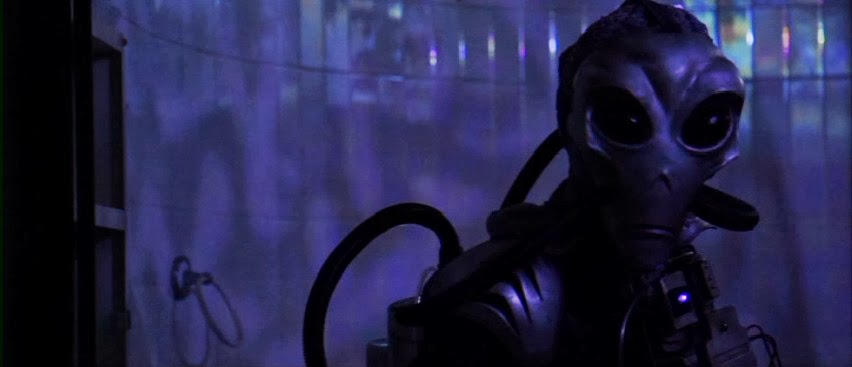
Art the Clown, brilliantly played by David Howard Thornton, is one of the film’s most unforgettable elements. His silent, exaggerated expressions and unnerving makeup make him a unique and unsettling character, reminiscent of horror icons like Pennywise and Leatherface. Art appears in each segment, his presence growing more chaotic and sadistic with each tale, proving that you don’t need a big budget to create a memorable monster. While some horror lovers will argue that Art’s over-the-top mannerisms take away from the tension of the film, I would argue that it does the opposite, adding to the absurdity of it all, giving us yet another reason to be uncomfortable and unsettled in this trio of terror.
Despite its status as a cult classic, All Hallow’s Eve has its shortcomings, which are typical of most indie horror films. The special effects, while extremely innovative, do at times fall flat, and the film’s low budget is apparent in its production quality. That being said, Leone compensates for this with dramatic, grindhouse-esque effects and an unnerving atmosphere. The pacing of the film can also be uneven, with some scenes feeling drawn out, especially in the second story, which delves into sci-fi territory but lacks the suspense it needs to push itself into true horror. While some might point out the film’s heavy reliance on familiar horror tropes such as a creepy clown, a demon-worshiping cult, a mysterious VHS tape, and a babysitter home alone with the kids, All Hallow’s Eve uses these classics well, feeling like an homage to horror itself, rather than a cheap cop-out.

While it may not be for everyone, All Hallow’s Eve is a compelling watch for fans of cult horror who enjoy a raw, unapologetically creepy experience. Its simplicity and focus on atmosphere make up for its lack of polish, delivering a deeply unsettling film that is worth a watch. If you’re looking for an eerie indie-horror film, All Hallows’ Eve has the right mix of unique storytelling, unnerving ambiance, grotesque imagery, and an enigmatic, unforgettable villain who inspires dread without ever uttering a single word.
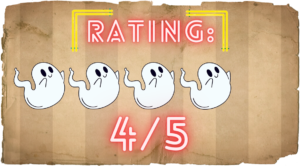
More Film Reviews
A film that begins by claiming everything we are about to see is based on true events, and ends with an imminent Apocalypse, puts the viewer in a strange… Pop culture is currently experiencing a boom of 1980s nostalgia. From Stranger Things on Netflix to Grady Hendrix’s My Best Friend’s Exorcism, science fiction and horror are squeezing every last… Witness protection isn’t enough to keep a mother and her young daughter safe, as the vigilantes hunting them down catch up to the pair. They want a confession the mother… What’s Happening on the 18th? Imagine waking up outside in the dead of night, and it’s pitch black except for brief flashes of lightning in the distance. Your body is… LandLocked 2021 kicks off with a video recording of a father telling his son that one week after he passes the house will be torn down and everything thrown out…. Sometimes a movie packs so much content and creativity that it’s easy to forgive any flaws along the way. Freaks Out, the latest effort from They Call Me Jeeg Robot director Gabriele…Return of the Living Dead (1985) Film Insight – Truth, Lies and More Brains
The Brain (1988) Film Review | Food for Thought
Motherly (2021) Film Review – Don’t underestimate a mother’s love
Open Grave (2013) Film Review – It’s Scarier Now, Ten Years Later!
LandLocked (2021) Film Review – Sometimes When You Stare Into the Past it Stares Back
Freaks Out (2021) Movie Review – Run Away And Join The Circus
As lover of cryptids, literature, and all things horror, I am so excited to be bringing my talents to the Grimoire of Horror. I am a librarian, avid gamer, TTRPG nerd, and a Mothman fangirl. I spent several years screening films for PRIMAA’s Canadian film festival Reel Shorts, and spent some time as an amateur horror filmmaker, competing in the Frantic 48 filmmaking challenge several years in a row. I love anything horror, from true crime to grindhouse to found footage and am especially interested in horror books and movies created by LGBTQIA2S+ and BIPOC as I think we have a fresh take on the genre and a fascinating perspective on what horror can be.

